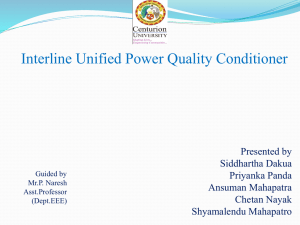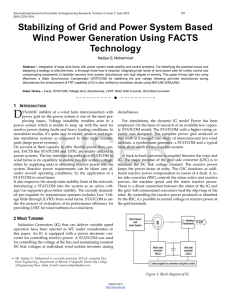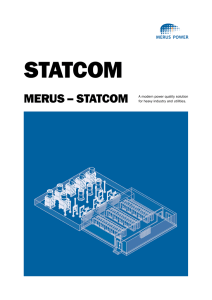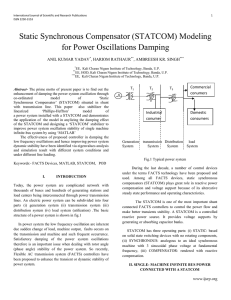Wind Power Plants with VSC Based STATCOM in PSCAD/EMTDC Environment Champa Nandi
advertisement
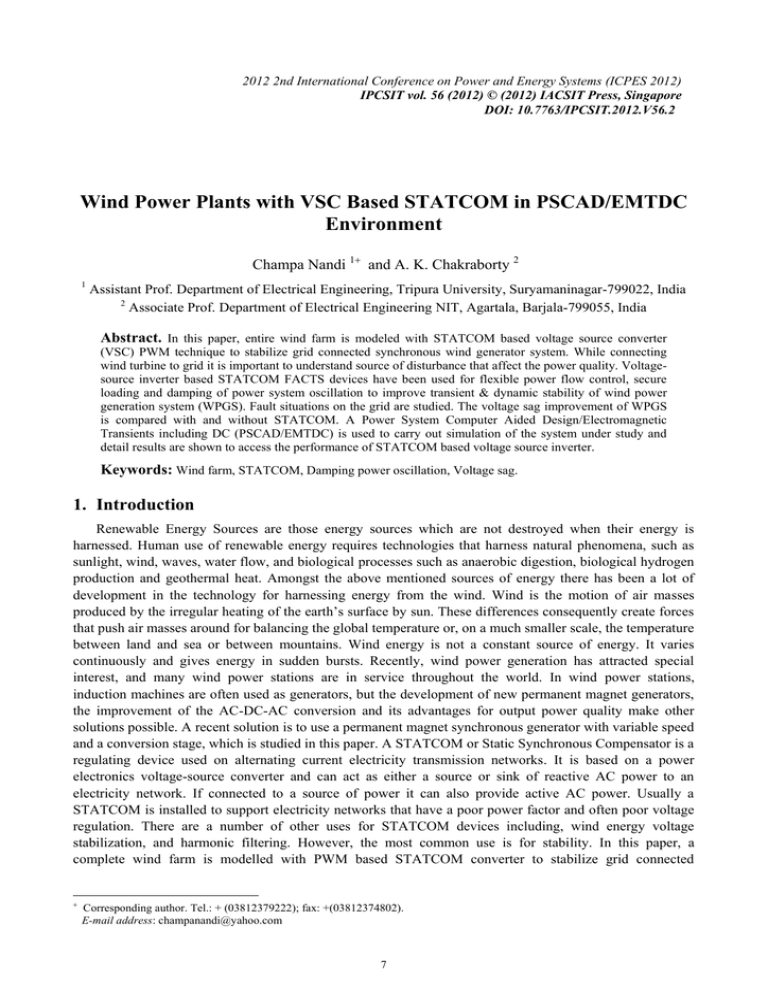
2012 2nd International Conference on Power and Energy Systems (ICPES 2012) IPCSIT vol. 56 (2012) © (2012) IACSIT Press, Singapore DOI: 10.7763/IPCSIT.2012.V56.2 Wind Power Plants with VSC Based STATCOM in PSCAD/EMTDC Environment Champa Nandi 1 and A. K. Chakraborty 2 1 Assistant Prof. Department of Electrical Engineering, Tripura University, Suryamaninagar-799022, India 2 Associate Prof. Department of Electrical Engineering NIT, Agartala, Barjala-799055, India Abstract. In this paper, entire wind farm is modeled with STATCOM based voltage source converter (VSC) PWM technique to stabilize grid connected synchronous wind generator system. While connecting wind turbine to grid it is important to understand source of disturbance that affect the power quality. Voltagesource inverter based STATCOM FACTS devices have been used for flexible power flow control, secure loading and damping of power system oscillation to improve transient & dynamic stability of wind power generation system (WPGS). Fault situations on the grid are studied. The voltage sag improvement of WPGS is compared with and without STATCOM. A Power System Computer Aided Design/Electromagnetic Transients including DC (PSCAD/EMTDC) is used to carry out simulation of the system under study and detail results are shown to access the performance of STATCOM based voltage source inverter. Keywords: Wind farm, STATCOM, Damping power oscillation, Voltage sag. 1. Introduction Renewable Energy Sources are those energy sources which are not destroyed when their energy is harnessed. Human use of renewable energy requires technologies that harness natural phenomena, such as sunlight, wind, waves, water flow, and biological processes such as anaerobic digestion, biological hydrogen production and geothermal heat. Amongst the above mentioned sources of energy there has been a lot of development in the technology for harnessing energy from the wind. Wind is the motion of air masses produced by the irregular heating of the earth’s surface by sun. These differences consequently create forces that push air masses around for balancing the global temperature or, on a much smaller scale, the temperature between land and sea or between mountains. Wind energy is not a constant source of energy. It varies continuously and gives energy in sudden bursts. Recently, wind power generation has attracted special interest, and many wind power stations are in service throughout the world. In wind power stations, induction machines are often used as generators, but the development of new permanent magnet generators, the improvement of the AC-DC-AC conversion and its advantages for output power quality make other solutions possible. A recent solution is to use a permanent magnet synchronous generator with variable speed and a conversion stage, which is studied in this paper. A STATCOM or Static Synchronous Compensator is a regulating device used on alternating current electricity transmission networks. It is based on a power electronics voltage-source converter and can act as either a source or sink of reactive AC power to an electricity network. If connected to a source of power it can also provide active AC power. Usually a STATCOM is installed to support electricity networks that have a poor power factor and often poor voltage regulation. There are a number of other uses for STATCOM devices including, wind energy voltage stabilization, and harmonic filtering. However, the most common use is for stability. In this paper, a complete wind farm is modelled with PWM based STATCOM converter to stabilize grid connected Corresponding author. Tel.: + (03812379222); fax: +(03812374802). E-mail address: champanandi@yahoo.com 7 synchronous wind generator system A theoretical and simulation study by PSCAD software of wind turbine generation is analysed by this paper. 2. Synchronous Generator Synchronous generators are doubly fed machines which generate electricity by the principle when the magnetic field around a conductor changes, a current is induced in the conductor. Typically, a rotating magnet called the rotor turns within a stationary set of conductors wound in coils on an iron core, called the stator. The field cuts across the conductors, generating an electrical current, as the mechanical input causes the rotor to turn. The rotating magnetic field induces an AC voltage in the stator windings. Often there are three sets of stator windings, physically offset so that the rotating magnetic field produces three phase currents, displaced by one-third of a period with respect to each other. The rotor magnetic field may be produced by induction by permanent magnets (in very small machines), or by a rotor winding energized with direct current through slip rings and brushes. The rotor magnetic field may even be provided by stationary field winding, with moving poles in the rotor. Automotive alternators invariably use a rotor winding, which allows control of the alternator generated voltage by varying the current in the rotor field winding. Permanent magnet machines avoid the loss due to magnetizing current in the rotor, but are restricted in size, owing to the cost of the magnet material. Since the permanent magnet field is constant, the terminal voltage varies directly with the speed of the generator. 3. STATCOM The STATCOM is shunt-connected reactive-power compensation device that is capable of generating and or absorbing reactive power and in which the output can be varied to control the specific parameters of an electric power system. It is in general a solid-state switching converter capable of generating or absorbing independently controllable real and reactive power at its output terminals when it is fed from an energy source or energy- storage device at its input terminals. Specifically, the STATCOM considered as a voltagesource converter that, from a given input of dc voltage produces a set of 3-phase ac-output voltages, each in phase with and coupled to the corresponding ac system voltage through a relatively small reactance (which is provided by either an interface reactor or the leakage inductance of a coupling transformer). The dc voltage is provided by an energy-storage capacitor. The VSC has the same rated-current capability when it operates with the Capacitive- or inductive-reactive current. Therefore, a VSC having certain MVA rating gives the ST ATCOM twice the dynamic range in MVAR (this also contributes to a compact design). A dc capacitor bank is used to support (stabilize) the controlled dc voltage needed for the operation of the VSC. The reactive power of a STATCOM is produced by means of power-electronic equipment of the voltage-source-converter type. A number of VSCs are combined in a multi-pulse connection to form the STATCOM. In the steady state, the VSCs operate with fundamental-frequency switching to minimize converter losses. However, during transient conditions caused by line faults, a pulse width-modulated (PWM) mode is used to prevent the fault current from entering the VSCs. In this way, the STATCOM is able to withstand transients on the ac side without blocking. A single-line STATCOM power circuit is shown in Fig.1 where a VSC is connected to a utility bus through magnetic coupling. Fig. 1: A single-line STATCOM power circuit 8 4. Simulation and Description In this PSCAD software simulation study a wind turbine connected to a permanent Magnet Synchronous Generator with 100 pole pairs (shown in fig. 2). The connection to the grid is then performed through a full AC/DC/AC converter. The main advantage of this strategy is to allow removing the gear box in the wind turbine. As the model represents only a single wind turbine, the firing angle of the thyristor is not controlled functions of the voltage level at the grid connection point but to keep the DC bus voltage to its rated level +/10%. The 6-pulse bridge can be used as a Thyristor bridge or a diode bridge but with a firing angle always set to 0.A 6 pulses PWM based STATCOM inverter is used for DC-AC conversion. After that it is connected with distributed grid where fault is applied for analysis (shown in fig. 3.). Fig. 2: Turbine Generator connection in PSCAD Environment Fig. 3: Complete wind farm model with STATCOM based voltage source converter connected to grid in PSCAD Environment 9 5. Results and Discussion 5.1. Voltage Sag improvement Fig. 4: Grid bus voltage without VSC based STATCOM Fig. 5: Grid bus voltage with VSC based STATCOM. From Fig. 4 it is seen that there is lots of oscillation in voltage characteristics graph. And from Fig. 5 it is clear that due to present of VSC based STATCOM voltage level of grid is 0.99 P.U. at healthy condition and at faulty condition this level is 0.96 P.U. which is in stable condition. Therefore voltage sag can be remove by using VSC based STATCOM. 5.2. Damping Power Oscillation From Fig.6 and Fig.7 it is clear that damping power oscillation can be controlled by using STATCOM based voltage source inverter. Fig.6: Generator output power without VSC based STATCOM 10 Fig. 7: Generator output power with VSC based STATCOM 6. Conclusion In this paper, a dynamic model of wind power plants has been presented. The simulations performed and analysis of concerned results indicates that the connection of a wind turbine cannot be done directly. STATCOM based voltage source inverter can improve voltage sag and voltage instability and it can control damping power oscillation. 7. References [1] PSCAD/EMTDC Power System Simulation’Simulation Software,user’s Manitoba HVDC Research Centre, Winnipeg Monitoba, 1996. [2] Yongning Chi, Yanhua Liu, Weisheng Wang, “Voltage Stability Analysis of Wind Farm integration into Transmission Network”, IEEE Trans. Energy Conversion 2006, 21 (1): 257-264. [3] P.M. Anderson, Anjan Bose. Stability Simulation of Wind Turbine Systems. Transactions On Power Apparatus And Systems, 1983.102(12): 3791-3795. [4] Series Device; Gabrijel/Mihalic. Direct Methods For transient stability assesment in power systems comprising controllable,2002.17(4). [5] Y.H.Song and A.T.Johns,. Eds. ,Flexible AC Transmission Systems (FACTS), IEEE press,London,1999 [6] PSCAD/EMTDC based simulation of a wind-diesel conversion scheme; Kannan Rajendiran; Curtin University of Technology, Perth, Australia; drdeadx@hotmail.com; IEEE 2000 11


